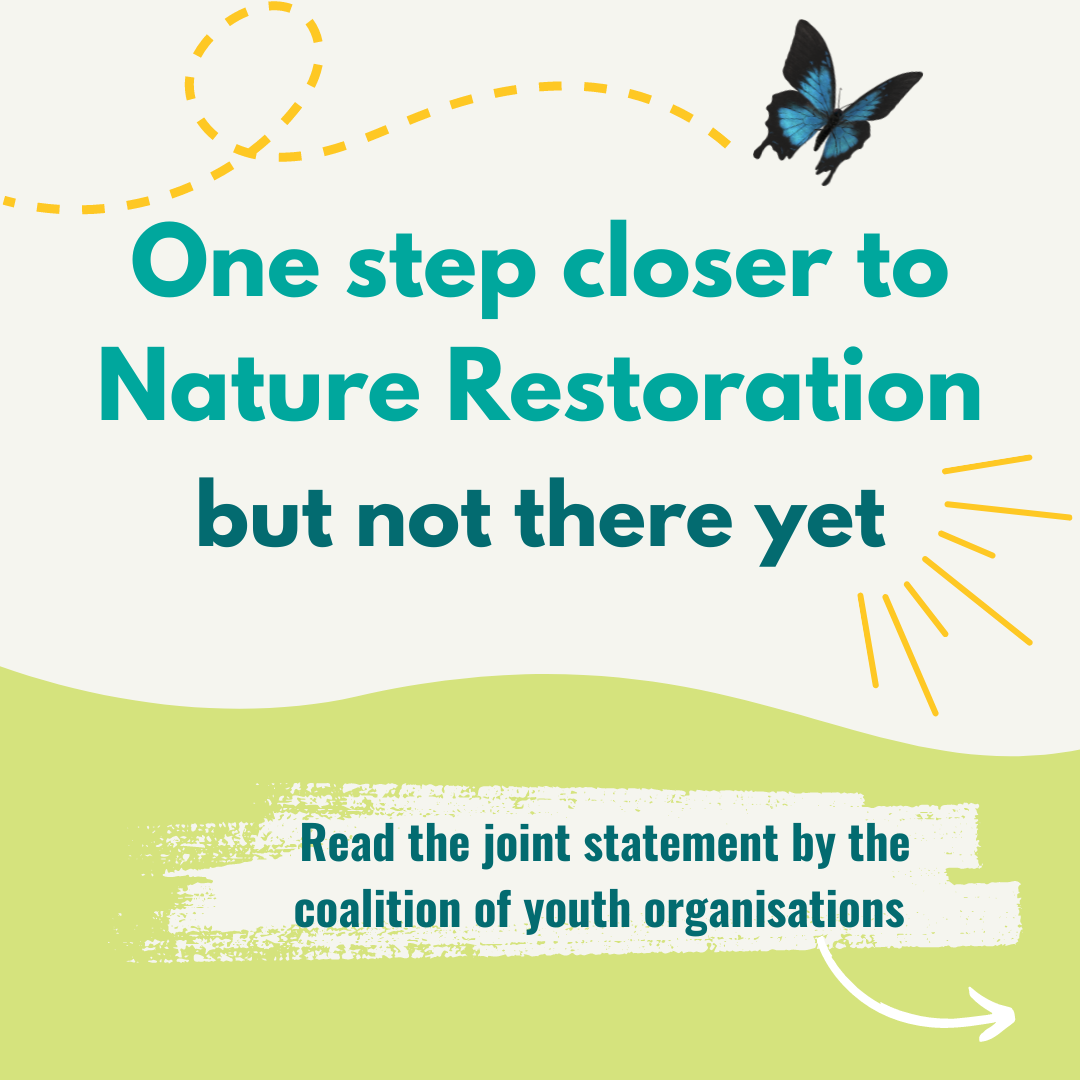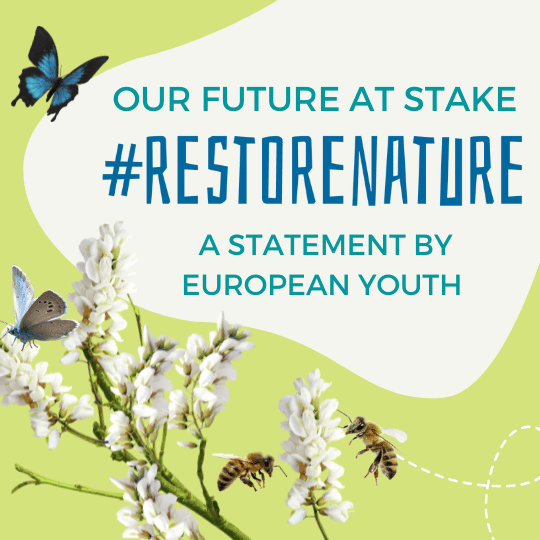
Summary
What are NRPs?
National Restoration Plans (NRPs) explain how each EU country will implement the Nature Restoration Law and how it achieves its targets for 2030, 2040, and 2050!
What is the problem?
- The proposed format fails to recognise youth participation.
- It does not offer countries the space to connect nature restoration with intergenerational equity.
What are our recommendations?
Youth Participation
- Add a “Youth Participation” section
- Ensure youth voices are documented
- Promote youth-led initiatives
Youth Contributions to Restoration Targets
- Recognise youth-led restoration projects
- Ensure youth have resources to contribute effectively
Intergenerational Equity
- New section: “Consideration of Future Generations”
- Make intergenerational equity a required principle in decision-making
Environmentally Harmful Subsidies
- Public funds shouldn’t support activities that harm biodiversity
- Concrete plans to phase out harmful subsidies
- Alignment with EU biodiversity commitment
The European Commission’s proposed uniform format for National Restoration Plans (NRPs) represents a thoughtful and comprehensive framework to support member states (MS) in achieving the ambitious targets set by the Nature Restoration Law (NRL). Nevertheless, reference to a core aspect that is key to the success of this Regulation is missing: youth. This omission is particularly significant, as young people will inherit the long-term consequences of environmental policies and have a crucial role to play in driving innovation, advocacy, and community engagement for successful restoration efforts. We therefore highly recommend the inclusion of the following:
Recognition of Youth Input in the Participation Process for NRPs
We propose adding a distinct priority under section 2.1, titled “Youth Participation,” within the “Public Participation” section. Young people’s lack of participation in environmental decision-making has been evident in the creation of National Energy and Climate Plans (NECPs). However, the NRL, and in particular, the NRPs, offer a valuable opportunity to address this gap by ensuring clear and dedicated participation pathways for young people within the NRL framework.
Following this, and for the purposes of Article 15(3(w)), we recommend more specificities to be added under Public Participation, such as subsections categorising the involvement of different stakeholders and the inputs they put forward. This way, the NRPs could provide a detailed explanation of the views expressed per category of stakeholder. We further recommend the addition of a section detailing the participation methods that the states followed (such as public consultations, multi-stakeholder group meetings, deliberations, etc…) and a short summary of each.
Youth Contributions to Restoration Targets
In addition to youth involvement in public consultations, we recommend that the NRP format include specific sections that highlight youth contributions to project implementation, citizen science, and advocacy efforts for restoration. For example, we suggest adding a new point (e.g., 14.5.5) to the format: “Describe the role of young people in the implementation of this measure.” This inclusion would support the alignment of restoration activities with national environmental citizen service programs or youth environmental corps, ensuring that young people are actively contributing to these important efforts.
Intergenerational Equity
We propose requiring MS to explicitly document how their plans address the rights of future generations. Intergenerational solidarity is recognised as a fundamental principle within the Treaty on European Union (TEU) and the Charter of Fundamental Rights. To incorporate this in NRPs and contribute to intergenerational equity, we suggest the following:
- Section 4.1.4: Include “intergenerational equity” as an example under “Other potential co-benefits.” Additionally, we support making this section mandatory instead of optional.
- Section 2.4: Introduce a new section titled “Consideration of Future Generations” to emphasize the importance of long-term planning.
- Section 14.3.4: Add a new section titled “Intergenerational Benefits” to highlight the advantages of prioritizing sustainability for future generations.
Environmentally Harmful Subsidies
In addition to Section 4.3.2, which gives an indication of the harmful subsidies that may negatively impact the achievement of the goals set under the regulation, we would like MS to explicitly include what actions are being taken to phase out the subsidies in question. We recommend expanding the section to include Subsection 4.3.2.1 titled “Actions taken to phase out environmentally harmful subsidies not in line with meeting the goals of the regulation”. In a parenthesis, examples can be included, such as “…(e.g. market-based instruments and green budgeting and financing tools)”. A reference to the supportive actions a state takes to phase out the specific subsidies, in line with the NRL Article 15(3(v)), would also be a useful addition to the format. This would also contribute to fulfilling Decision (EU) 2022/591 Art 3(2(h)), according to which MS “shall identify other environmentally harmful subsidies and report them regularly to the Commission”. Incorporation of more information about environmentally harmful subsidies in the NRL would therefore have multiple positive effects. In support of the latter, we would also like to draw attention to Recommendation 9 of a joint CSO statement on the EU budget for biodiversity, which calls for the harmonisation of the identification of environmentally harmful subsidies, and of a reporting mechanism. Lastly, we would like to draw attention to point 3.2 of NAT/926 of the EESC’s own initiative opinion titled “A comprehensive strategy for biodiversity at COP16”, which highlights the urgency of phasing out environmentally harmful subsidies for the purposes of biodiversity governance.
Help us spread the word! Share this statement.
This feedback was jointly developed by



Learn more about the EU Nature Restoration Law

National Restoration Plans (NRPs) are a cornerstone of the Nature Restoration Law (NRL), outlining how Member States (MS) will implement the regulation

YEE and other youth organisations have sent this letter to European Parliament Members, ahead of the plenary vote on the Nature Restoration

Join us and over 200 NGOs and ask your decision-makers to adopt a solid and urgent implementation of the law that can
Feedback on National Restorations Plans’ format
https://yeenet.eu/wp-content/uploads/2024/02/position.png 250 250 YEE https://yeenet.eu/wp-content/uploads/2018/11/logo-yee-728x1030.png YEE2025-02-07 15:23:032025-02-20 09:43:59Feedback on National Restorations Plans' format
As a youth-driven environmental NGO, our mission has always been rooted in transparency, accountability, and solidarity. After careful deliberation, we have made the decision to leave X (formerly Twitter). This choice reflects our commitment to aligning our actions with our values and taking a stand for ethical digital spaces.
X’s current environment no longer supports meaningful engagement or equitable advocacy and remaining in the space would only lend credibility to a platform that actively undermines principles of transparency and accountability—principles core to our mission. Staying would require us to divert valuable resources into a platform that is increasingly misaligned with our purpose.
We are leaving X as a political statement and an act of solidarity with others who are advocating for responsible and ethical alternatives. We remain steadfast in our mission and will continue to amplify our voice on other platforms where we can engage meaningfully.
We invite you to follow us on other platforms and subscribe to our newsletter to stay connected as we continue to fight for a just and sustainable future.
Why we left X
https://yeenet.eu/wp-content/uploads/2025/01/Leaving-X-.png 417 417 YEE https://yeenet.eu/wp-content/uploads/2018/11/logo-yee-728x1030.png YEE2025-01-20 06:03:292025-01-20 07:02:22Why we left X
Green light to wolf hunting in Europe: youth, science and civil society go unheard.
As young people, we are beyond baffled to see that European countries support lowering the protection status of wolves in Europe, paving the way for increased wolf hunting in the 21st century. After almost a year since the Commission’s proposal to downgrade the wolf status in Europe, the final vote has been cast, flushing decades of conservation work, money and science down the drain. And, once again, it is us, young people, who will face the consequences of this unscientific and irresponsible decision.
On December 3rd, at the 44th Standing Committee Meeting of the Bern Convention in Strasbourg, the proposal to downlist the wolf was welcomed with a staggering 38 countries voting in favour. We must also acknowledge the following countries for opposing this proposal, voicing their concern regarding the evidence presented (or lack thereof), and noting the troubling precedent this decision sets: The United Kingdom, Bosnia & Herzegovina, Monaco, Albania and Montenegro. We urgently call upon these same countries to again voice their opposition before this decision comes into force in 3 months and for others to join them.
Fearmongering, hate and the spread of misinformation in Europe seem to have become common in narratives around conservation. Coexistence measures and modern technology, in which many young Europeans are now involved, are effective means of reducing human-wildlife conflict across the continent, and this is what European institutions should promote.
It is disconcerting how easily the European Union has ignored repeated calls to reason by citizens and scientists alike, in favour of political interests. Even today in Strasbourg, interventions made by multiple NGOs present as observers in the 44th Standing Committee Meeting went ignored (Pro Natura, Birdlife International, Born Free Foundation).
Full statement
The fact that wolves are now present in nearly all EU member states is in no small part thanks to conservation efforts and the legal protection provided by instruments like the Bern Convention. This proposal to lower the protection status of wolf populations can’t be justified based on current scientific evidence relating to the threats wolves still face. In addition, for wolves to effectively fulfil their ecological function, they must persist in ecologically sufficient numbers. Current data also indicates no notable increase in livestock damages or public safety risks caused by wolves since 2022. When a proposal to lower the protective status was brought to this committee.
The Swiss proposal in 2022 to downlist wolves I am referring to, was rejected by the Standing Committee, based on a report by the Large Carnivore Initiative for Europe (LCIE) highlighting the conservation status of European wolf populations at the time. The LCIE again released a statement on November 13th expressing their concern and highlighting what seems to be a cherry-picking of scientific evidence in the current proposal.
In justifying their decision to vote against the Swiss proposal the EU said the following, and I quote.
“Based on current data, lowering the protection status of all wolf populations is not justified from a scientific and conservation point of view. The conservation status of the species remains divergent across the continent, with a favourable conservation status assessment in only 18 out of 39 national parts of biogeographical regions in the Union. Continuing threats to the species, including emerging ones such as border fences and wolfdog hybridisation, also call for maintaining the strict protection status.”
This begs the question, what has changed 2 years since? The answer is virtually nothing. At least as far as the wolves are concerned. What has changed however is the political climate.
So, the European Union’s current decision to propose downlisting wolves appears inconsistent with its earlier stance. The same arguments that prompted the EU to oppose the Swiss proposal two years ago remain relevant today, raising concerns about the rationale behind the EU’s shift in position.
In light of ecological reasoning and prior political commitments, the proposed downlisting of wolves threatens to undermine the progress made in their conservation and sets a troubling precedent for future proposals for downgrading the protected status of other species in Appendix II. Given the fact that the convention does not set out specific science-based guidelines for such an action.
Downgrading the protective status of the wolf will make it easier to implement lethal control measures which are already being implemented with questionable reasoning. The science is clear on this, the decision to kill, legally or not, individuals of a protected species, such as wolves, risks diminishing their perceived value and undermining conservation efforts. As a young person from a country where most of my generation did not grow up with these amazing animals, this is not the right step toward coexistence with large carnivores, and nature as a whole, I want to see.
This move, which makes the wolves scapegoats and will not fix the struggles of rural areas finding it difficult to coexist with these animals, not only jeopardises the ecological functioning of European ecosystems but also sets a very dangerous precedent on how fragile European laws and democracy are in front of lobbying by few.
As European youth, we hold all relevant decision-makers accountable for this grave backsliding in European conservation law. We call for the return of scientific reason and intergenerational fairness on the decision-making table. We wish to see this decision not to be applied in EU law, and to be reversed as soon as possible.
Read the first youth position here.
Help us spread the word! Share this statement
Signatories




Statement on lowering the protection status of wolves
https://yeenet.eu/wp-content/uploads/2024/02/position.png 250 250 YEE https://yeenet.eu/wp-content/uploads/2018/11/logo-yee-728x1030.png YEE2024-12-04 11:57:002025-02-07 15:27:26Statement on lowering the protection status of wolves
This manifesto, created by young advocates, calls for transformative change in the textile industry by 2050. It envisions a future where textiles contribute positively to environmental and social wellbeing through new principles focused on culture, production, and communication.
Core Themes:
- Textile Cultures: Moving towards a model of ownership based on reciprocity and transparency, rooted in sustainable practices and mutual respect across cultures.
- Textile Production: Emphasising circular, non-toxic processes, fair labour practices, and extended product life cycles to reduce waste and promote high-quality, sustainable products.
- Textile Communication: Advocating for transparent, honest, and inclusive communication that eliminates greenwashing and empowers consumers.
Background:
This manifesto emerged from the Youth Forum on Sustainable Fashion Consumption, supported by the UN Environment Programme and EU policymakers, underlining young people’s role in reshaping the textile narrative. It’s a call to action for policymakers, industry, and consumers to collaborate on a just transition.
Help us spread the word! Share this manifesto:
Supported by:







Youth Manifesto for Systemic Transformation in Textiles
https://yeenet.eu/wp-content/uploads/2024/02/position.png 250 250 Eva Kloudová https://yeenet.eu/wp-content/uploads/2018/11/logo-yee-728x1030.png Eva Kloudová2024-11-14 12:50:442024-11-14 13:00:02Youth Manifesto for Systemic Transformation in Textiles
1. Mitigation
Position
If we hope to avoid the worst consequences of the climate crisis and protect the most vulnerable from consequences beyond finance and adaptation capabilities, mitigation needs to return to the centre stage of the UNFCCC process in order to keep global warming under 1.5°C. This means that the Sharm el-Sheikh mitigation ambition and implementation work programme needs to be strengthened to enable it to deliver on substantive outcomes in line with the mitigation relevant sections 20-42 of last year’s GST Decision 1/CMA.5 through technical dialogues and partnerships. It also means that all countries need to submit updated NDCs by early 2025 in line with the 1.5° target, including concrete roadmaps towards an implementation of 28/CMA.5.
Strategic Demands
- Sharm el-Sheikh Work Programme: We call on parties to review and improve the modalities of the Sharm el-Sheikh mitigation ambition and implementation work programme so as to guarantee that the implementation and continuation of the programme results in substantive outcomes on the decisions reached on mitigation action under 28/CMA.5, including the tripling of renewables, the doubling of the rate of energy efficiency improvements and the transition away from fossil fuels in energy systems. This can be achieved inter alia by having technical dialogues focused on sub-sections of 28/CMA.5, enabling funded mitigation action partnerships and placing high-level political messages on mitigation in the annual report and CMA decision at each COP session.
- Nationally Determined Contributions: we urge Parties to submit updated NDCs which are aligned with CMA.5 and with the 1.5°C degree goal of the Paris Agreement. The NDCs should include economy-wide reduction targets that cover all GHGs and sectors, aim for net zero latest by 2050, 2040 for industrialised economies, and are underpinned by concrete roadmaps for the implementation of 28/CMA.5.
- EU NDC: As Europeans, we specifically urge the EU and its member states to commit to an ambitious new EU NDC in line with the 1,5 degree temperature limit and aiming for net zero by 2040 to be developed in collaboration with civil society and especially youth, to be announced before SB62 in 2025. This updated NDC shall also include a roadmap for 28/CMA.5, which could become a reference point for others to do the same.
- Nature-based solutions: we urge Parties to develop nature-based solutions for national action plans and emphasise ecosystem restoration and conservation. Hereby, industrialised countries need to support the Global South. Safeguards to secure the achievement of climate and biodiversity benefits, in particular strengthening resilience, in the implementation of nature-based solutions for mitigation should be promoted and prioritised. These nature-based solutions should be implemented without compromising the diversity of ecosystems, including marine, forest and urban areas.
- Green skills: we ask Parties to commit to support and fund the development of green skills for young people, so as to place them at the centre of the just transition.
- We furthermore call for an improvement regarding the accessibility of funds and technologies to grassroots community projects on mitigation, working on patents and other barriers to transfer.
- Phase out fossil fuels: We call for the EU to be at the forefront of a global movement to phase out fossil fuels, without caveats such as “unabated” fossil fuel phaseouts. This means committing to an end of domestic use of coal by 2030, fossil gas by 2035, and oil by 2040. In line with 28/CMA.5, the goal of tripling renewable energy and doubling energy efficiency improvement rates globally needs to be reached as quickly as possible. To implement this, we urge the EU, its member states and other European nations to:
- ○ shift fossil fuel subsidies to renewable energy by 2030 at the latest;
- ○ endorse the Fossil Fuel Non-Proliferation Treaty (FFNPT) and encourage other countries to also sign; and
- ○ commit to a time-bound phase-out of fossil fuels.
- Plants-based food systems: We call for a transition towards plant-based food systems supported by government subsidies and investment, emphasising the significant mitigation benefits of sustainable food reform in the light of the climate crisis – given that our global food system accounts for around one-third of GHG emissions – and recognising the need to tackle global food insecurity, environmental degradation, antibiotic resistance, and zoonotic diseases. In line with ProVeg International’s mission, we urge Parties to commit to replacing 50% of animal-based products with plant-based and cultivated foods by 2040.
2. Adaptation
Position
Adaptation measures must be prioritised alongside mitigation efforts, recognising both adaptation and mitigation as necessary in the climate actions of all member states to the UNFCCC. Given the urgency of climate impacts, especially in certain regions, it is essential to establish a differentiated adaptation regime that responds to specific local needs. We urge policymakers to reflect this equal prioritisation, ensuring adaptation receives commensurate attention, funding, and implementation focus alongside mitigation strategies.
Strategic Demands
- Progress under the UAE-Belém Work Programme with increased Specificity and Process Clarity: at COP29, Parties must collaborate to establish a coherent approach to achieve significant progress in the UAE-Belém work programme’s second year. Enhanced dialogue between negotiators and technical experts is essential to strengthen this workstream. Given the limited time at COP29 and over 5,000 adaptation indicators from various actors, we urge a streamlined approach to enable meaningful engagement and results.
- Means of Implementation (MoI): indicators under the Means of Implementation (MoI) need clear linkages to measurable targets, which currently remain a gap.
- New Collective Quantified Goal (NCQG) Alignment: we advocate for alignment and integration between NCQG discussions and the UAE-Belém work programme’s methodologies. The NCQG must also consider adaptation’s evolving needs.
- Grants-based and locally appropriate adaptation finance: funding for adaptation needs to be grants-based, and locally appropriate and must prioritise the countries and communities that are most in need. This should be accomplished by improving access to funds for grassroots community projects with a long-term focus. Additionally, it should include advancements in technologies and best practices, as well as the removal of barriers like patents to ensure equitable technology transfer.
- Adaptation Fund: The 2023 fundraising campaign for the Adaptation Fund is likely to fall short of its expected $300 million for the second year in a row. This fund plays a vital role in directly supporting marginalised communities most impacted by climate change (MAPA). COP29 must prevent further funding deficits and ensure that the Adaptation Fund remains well-resourced to support its project portfolio and long-term sustainability.
- Support to National Adaptation Plans (NAPs): we call for robust technical and financial support for the development and transparent monitoring of National Adaptation Plans. NAPs should integrate disaster risk management strategies that protect natural ecosystems and prioritise stakeholder engagement, especially in ecosystem-based adaptation.
- Adaptation in Nationally Determined Contributions (NDCs): countries, particularly in the Global North, must integrate adaptation and loss and damage more comprehensively into their NDCs. While many developing countries have included adaptation elements, stronger commitments are required globally for coherent and balanced climate action.
- Inclusive, locally-led adaptation: adaptation projects must meaningfully involve local communities, ensuring fair wages, capacity building, and access to advanced technologies. Special attention must be given to developing countries and vulnerable populations, ensuring that adaptation builds local resilience and enhances livelihoods.
- Ecosystem and community-based resilience: all adaptation initiatives should focus on creating green spaces, improving air quality, enhancing sustainable transportation options, and ensuring access to clean water and nutritious food. These efforts not only build resilience to climate impacts but also contribute to overall community well-being and social cohesion. We call for significantly increased investment in clean energy infrastructure, sustainable transportation, and ecosystem restoration, recognising these as investments in future generations’ well-being.
- Disaggregated data: we urge the use of age-, sex-, and disability-disaggregated data, along with child- and youth-specific indicators, in tracking adaptation outcomes under the UAE-Belem Work Programme. Experts must consider the unique needs of the most affected groups in formulating adaptation indicators.
- Climate mobility: National Adaptation Plans (NAPs) must recognise refugees from climate-vulnerable countries and prioritise climate-induced mobility, providing necessary protection and support for those displaced by climate impacts.
3. Loss and Damage
Position
There is a duty, particularly in the Global North and Parties in a position to do so, such as the EU, to provide adequate compensation for loss and damage to the most affected and vulnerable countries and communities. Funding for Loss and Damage initiatives should be adequate, equitable, additional and predictable, with a needs-based, rights-based and grant-based approach.
Strategic Demands
- We urge Parties to establish a third pillar for Loss and Damage in Climate Finance – that is, to include Loss and Damage in the New Collective Quantified Goal (NCQG), including in the form of a (regularly reviewed and adjusted) sub-goal expressed exclusively as grants.
- High-income countries, historical emitters and Parties in a position to do so must pledge new contributions to the Loss and Damage Fund. These should truly reflect their responsibility for the climate crisis and their economic capabilities to contribute and need to be new and additional to pre-existing funding under climate finance, humanitarian and developing funding.
- Financial instruments used to provide climate finance must not exacerbate the debt burdens of developing nations. The quality of climate finance is as critical as its quantity.
- We encourage Parties to establish mechanisms to address systemic information gaps through qualitative and quantitative indicators of non-economic and economic impacts.
- We recommend that Parties commit to ensuring transparency in the allocation of resources through mechanisms and robust monitoring.
- We urge Parties to recommend the establishment of mapping and data collection systems to analyse non-economic losses and damages in order to develop action plans at the country level.
- The Loss and Damage Fund shall be operationalised according to the gender and human rights-based approach, giving adequate attention to economic and non-economic losses and damages.
- Issue guidance to the FRLD board to ensure adequate capitalisation of the Fund, access to funding for and meaningful participation in decision-making of Indigenous Peoples, frontline communities, local CSOs and groups experiencing marginalisation.
- Ensure rapid, grant-based capitalisation of the Fund to respond to economic and non-economic loss and damage, based on public finance, rights-based, regular, predictable, needs-driven, structured and accessible to vulnerable groups and communities such as youth and indigenous peoples.
- We urge Parties to agree on starting to disburse the Loss and Damage Fund by Early 2025.
- We call Parties to establish national focal points for loss and damage (LD) to improve coordination.
4. Climate Finance and NCQG
Position
Climate finance is central to meaningful action at COP29, particularly in advancing climate adaptation, mitigation, and addressing Loss and Damage. It is the key issue at the conference, as critical initiatives around the world remain underfunded, and developed countries have consistently failed to fulfil their commitments to provide sufficient financial resources to support vulnerable nations.
The current global financial system has fallen short in mobilising the necessary resources to tackle the climate crisis. In light of Article 2.1(c) of the Paris Agreement, which calls for a transformation of the financial system to build resilient and sustainable economies, we assert that scaling up the New Collective Quantified Goal (NCQG) is essential to addressing this imbalance. It is a collective responsibility to ensure that those who have contributed most to climate change—both in the public and private sectors—contribute accordingly.
To achieve this, climate finance must prioritise grants over loans, leverage public funding, and hold polluting industries accountable through taxes on their environmental impact. This approach will ensure that funding is more accessible and effective, driving the much-needed climate action to mitigate future risks and build resilient communities. It is of paramount importance to prevent interest rates that place most affected countries into heavier debt.
Additional sources of finance should be considered in this respect, most importantly, phasing out fossil fuel subsidies and their reallocation to just transition efforts, but also wealth tax, tax on financial transactions, windfall profit tax on fossil fuel companies, carbon levy on private jets and yachts, etc.
Strategic Demands
- Grants over loans: we demand the NCQG to prioritise grants over loans for climate finance, ensuring that public funds form the core of contributions to avoid deepening debt crises in most vulnerable and developing countries.
- Financing from polluters: climate finance contributions must be supplemented by taxes on polluting industries (such as fossil fuel companies), luxury goods, and services like private jets. Corporations must be held accountable through carbon taxes and special levies to fund climate action.
- Tax Justice, make polluters pay: we call for the recognition of the principles of tax justice and ‘polluter pays’ within the frame of equity and common but differentiated responsibilities and respective capacities (CBDR-RC). Developed countries should take the lead in reorienting their existing public finances to do no harm, and pursuing tax justice for new sources to be able to provide new and additional climate finance under the NCQG.
- $5 trillion climate debt repayment: the Global North must commit to a minimum $5 trillion annual climate debt repayment package, starting with at least $1 trillion in grants each year from COP29 onwards to cover adaptation, loss and damage, and a just transition. Private investments must not substitute this obligation.
- Direct access: funding must be directly accessible to vulnerable communities, cutting out intermediaries and simplifying processes, with special attention to local leaders and youth (both organised and unorganised entities) to empower them to lead green projects.
- Transparent and equitable finance: the NCQG must ensure transparent, additional funding for mitigation, adaptation, and Loss and Damage, with developed countries meeting existing commitments before broadening the donor base.
- The decision to adopt the NCQG must recognise the importance of funding across multilateral environmental agreements, including for the Kunming-Montreal Global Biodiversity Framework and the Global Framework on Chemicals;
- Youth projects: we urge to facilitate access to finance for youth-led sustainable projects, including from multilateral institutions and funds as well as national resources to support NDC-aligned local projects.
5. Climate Justice
Position
Nationally Determined Contributions (NDCs) and long-term climate strategies must integrate just transition principles and social investments, including infrastructure, education, skills development, and social protection measures.
COP29 must prioritise a fair and inclusive approach, recognizing that communities most affected by the climate crisis are essential actors, not just victims, in addressing its impacts
Strategic Demands
We call for recognition and support of those facing the worst impacts:
- EU support in the context of just transition: a robust inclusivity approach is crucial to enabling equitable climate solutions. The EU governments should ensure that climate policies are increasingly fair and inclusive to recognise evolving changes that arise as a result of the climate crisis. Particular attention shall be devoted to young people transitioning from education to work, workers, minority groups, and low-income populations.
- ○ Just transition: European governments should implement support and retraining programs for workers transitioning out of fossil fuel industries, ensuring they are not disadvantaged during the renewable energy transition.. This is essential to maintaining fairness and social stability in climate policy.
- ○ Support to low-income populations: European governments must implement climate solutions that avoid obligating low-income populations to disproportionately burdensome responsibilities.
- Engagement with the Global South: European governments should engage directly with minority and vulnerable communities in the Global South, ensuring their voices are heard in both national climate plans and at COP29. The Global South’s participation is vital in crafting equitable climate solutions.
- Inclusive participation
- ○ At the national level: countries should involve a diversity of groups, including youth, women, Indigenous Peoples, and people with disabilities in the development and implementation of national climate strategies. This should be done in close collaboration with the groups themselves, giving them the means to influence throughout the whole process, with a focus on empowering marginalised groups.
- ○ In UNFCCC processes: we urge the UNFCCC to ensure meaningful and inclusive participation in negotiations and decision-making processes. This includes governments and corporations providing equal opportunities and ensuring that people from diverse socioeconomic and geographical backgrounds are heard, including youth, women, Indigenous People, and people with disabilities. We recognise that all voices must count equally to achieve equitable and effective climate solutions.
- International Court of Justice Advisory Opinion:
- ○ We urge States participating in the International Court of Justice Advisory Opinion (ICJAO) on Climate Change oral proceedings to include witness testimonies from youth, indigenous communities and other marginalised groups in their oral statements. Their lived experiences are critical in shaping climate justice outcomes.
- ○ We invite States to address the importance of intergenerational equity and respect for human rights in the face of climate change during their oral statements at the ICJ. We also encourage them to mention citizen-led initiatives for the ICJAO campaign, such as the witness stands and the ICJAO petition.
6. Action for Climate Empowerment (ACE)
Position
In line with Action 55 of the UN Pact for the Future, we call on Parties to provide meaningful opportunities for the participation of non-state actors in the UNFCCC negotiations, including young people, local communities, women, trade unions, indigenous people, academia, etc. and ensure that the outcomes of these deliberations are feeding into the negotiations. We commend the recognition of youth in the UNFCCC process, including through the establishment of the Youth and Children Constituency (YOUNGO), the acknowledgement of the need to ensure meaningful youth participation, and representation in the Glasgow Climate Pact and Glasgow work programme on Action for Climate Empowerment as well as the establishment of the Children and Youth Pavilion and Youth Climate Champion.
However, many Parties have still not involved youth as full stakeholders in the process both at the national and international levels. Youth inclusion is a two-way process, which requires both sides to develop the skills and willingness to collaborate meaningfully.
Strategic Demands
- We call on Parties to involve youth as full stakeholders in national and international climate negotiations. This includes:
- ○ Mandatory youth inclusion in Party delegations.
- ○ Pre-sessional and on-site youth consultations.
- ○ Youth-led forums for dialogue with Parties, as set out in the Glasgow Work Programme on ACE.
- ○ Enhanced opportunities for youth to participate in technical dialogues and provide interventions.
- ○ Sponsorship and support for youth participation in UNFCCC processes.
- We urge Parties to not only focus on building the capacity of youth to engage in political processes but also to develop their own capacity to effectively collaborate with youth and vulnerable groups. This should include practical training for Party negotiators on inclusive decision-making processes.
- Mainstream ACE principles across workstreams: ACE principles—climate education, training, public awareness, and public participation—must be integrated across all UNFCCC workstreams. We demand that the NCQG agreement allocate specific finance for ACE to uphold the procedural rights of Environmental and Human Rights Defenders (ERHRDs) in climate action.
7. Civic Space, Human Rights and Conflict of Interest
Strategic Demands
- There is no climate justice without human rights:
- The EU must lead in safeguarding human rights in climate processes while ensuring meaningful participation from civil society and frontline communities.
- Local activists must be protected and allowed safe participation in key climate fora such as COPs.
- Civic space:
- The UNFCCC and Azerbaijani authorities must facilitate inclusive participation at COP29 by ensuring access, freedom of expression, and peaceful protest rights. Azerbaijan should guarantee civic space and establish a system for responding to threats to human rights during the event.
- Conflict of interest:
- We call on the EU to push for a robust UNFCCC Accountability Framework to define and regulate conflicts of interest, to prevent undue corporate influence and ensure transparency in participant admissions.
- The UNFCCC Secretariat should stop inviting industry associations linked to polluting interests and strengthen guidelines to prevent the misuse of the COP brand by host countries.
- The Host Country Agreement as well as any contracts involving corporations and organisations granted (Green Zone) partner or exhibitor status should be published on the UNFCCC website.
8. Planetary Boundaries
Position
Only three planetary boundaries remain within the “safe operating space”: ocean acidification (which is already approaching its critical threshold), atmospheric aerosol loading, and stratospheric ozone depletion.
All other boundaries – such as climate change, biosphere integrity (biodiversity loss), land-system change, freshwater change, and biogeochemical flows – have been surpassed.
The interconnected nature of these planetary boundaries means that addressing individual challenges, like limiting global warming to 1.5°C, demands a collective and integrated approach. Tackling one issue without considering others risks destabilising the entire Earth system.
Strategic Demands
- The European Union must take bold action to strengthen its Nature Restoration Law, increasing its ambitions, and enforcing legally binding targets for restoring degraded ecosystems and halting biodiversity loss. This includes scaling up nature-based solutions, protecting critical habitats, and integrating biodiversity goals into all sectors of the economy. As past experience has shown, compromise in this area is not an option, as the sustainable growth of economies and the well-being of citizens are intrinsically linked to a healthy, thriving natural environment.
- The private sector must significantly scale up its financial and structural commitments to biodiversity protection, as the majority of current funding comes from governments, which are providing insufficient resources to meet the targets set in the Kunming-Montreal Global Biodiversity Framework. Different types of instruments can be considered to improve investment in nature and biodiversity, like the debt-for-nature swap and green bonds.
- Furthermore, governments and institutions should focus on the strengthening of Multilateral Development Banks transforming them into climate and nature banks.
- The European Union should not delay the EU deforestation-free products regulation (EUDR), a flagship achievement of the Green Deal.
9. Health
Position
The climate crisis poses a significant threat to global health and well-being in the 21st century. As young Europeans, we are deeply concerned about the direct and indirect impacts of climate change on health, social systems, and overall quality of life.
Strategic Demands
To address these interconnected issues, we call on European Governments to include the following in their positions in the UNFCCC:
- Recognise the profound and interconnected impacts of the climate crisis on health, social systems, and well-being in their verbal and written statements in the UNFCCC context.
- Integrate climate considerations into all health policies and planning processes.
- Strengthen healthcare infrastructure to withstand climate-related disruptions.
- Increase investment in research on climate-health impacts and effective adaptation strategies, prioritising the needs of vulnerable populations in climate-health action plans.
- Promote sustainable practices in healthcare and other sectors to mitigate climate change.
- Enhance education and awareness about climate-health links, particularly among youth.
- Ensure youth representation in climate-health policy-making processes to address the long-term nature of these challenges.
Help us spread the word! Share this statement
Signatories
This position paper was developed within the Network of European Youth NGOs for Climate Action (NEYCA).



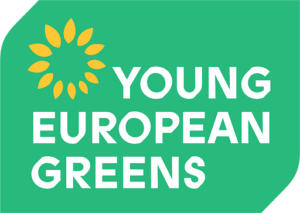
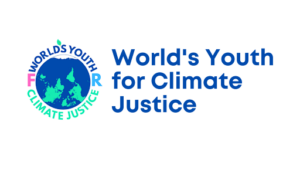







European Youth Demands for COP29
https://yeenet.eu/wp-content/uploads/2024/11/neyca.png 512 462 Eva Kloudová https://yeenet.eu/wp-content/uploads/2018/11/logo-yee-728x1030.png Eva Kloudová2024-11-07 11:37:172024-11-08 11:50:17European Youth Demands for COP29
The declaration by the United Nations to consider this decade, the UN decade of ecosystem restoration, acknowledges decades of research urging us to take action to prevent further degradation of our natural world and restore what has been degraded. Although there is still a long way to go in achieving this goal, COP 16 must be a step towards finally taking action to restore ecosystems.
We recognise that biodiversity loss and ecosystem degradation disproportionately affect the most vulnerable communities, particularly those already marginalised by systemic inequalities, such as Indigenous Peoples, local communities, women, youth, people with disabilities, and those living in poverty. Biodiversity policies must therefore prioritise equity, social justice, and the inclusion of these groups in decision-making processes, as their unique knowledge and perspectives are critical for developing effective solutions.
As young people in Europe, we expect European countries at COP 16 of the Convention on Biological Diversity (CBD) to prioritise bold, actionable solutions that address the ongoing catastrophic global biodiversity loss and recognise our continent’s crucial role in addressing the crisis. We want concrete commitments to protect and restore ecosystems, ensure sustainable use of natural resources, and safeguard the rights of Indigenous communities. Our present and future depend on a healthy planet, and we expect nothing short of world leaders acting swiftly to implement the Global Biodiversity Framework, hold corporations accountable, and invest in nature-based solutions; all this underpinned by principles of solidarity and leaving none behind.
As for concrete text proposals, we support the policy paper by the Global Youth Biodiversity Network and the Opinion by the European Economic and Social Committee NAT/926 ‘A comprehensive strategy for biodiversity at COP16: bringing all sectors together for a common goal’. Still, as European Youth, we want to emphasise the following aspects:
We believe that COP16 decisions need to entail:
Inclusive and Equitable Biodiversity Strategies in NBSAPs
Global targets are translated into national implementation through the NBSAPs, which must be well-designed (i.e. whole-of-society and whole-of-government approach) and supported by a strong monitoring framework. However, the design of NBSAP should not delay biodiversity action: we have plenty of ready and proven solutions to tackle biodiversity loss that need to be accelerated. The European Union (EU) and its Member States should align their NBSAPs to the ambition of the EU Biodiversity Strategy, which, with its legislation like the Nature Restoration Law and the Deforestation Law, are already urging action.
As a region with high capabilities to do so, European countries should ambitiously support wildlife comeback and coexistence in their own continent, and have a duty to restore lost habitat and species populations besides protecting the few that are left.
When designing and implementing NBSAPs, we believe that the targets that differ most from former Aichi targets need to be especially considered, to make sure the NBSAPs address them properly. In particular, this includes Targets 22 and 23, which focus on critical areas of inclusivity. Target 22 emphasises the full and equitable participation of Indigenous Peoples, local communities, women, and youth while ensuring their rights to lands, territories, and resources are respected. Target 23 calls for gender equality and the empowerment of women and girls in biodiversity decision-making and leadership. We believe that these targets are essential to achieve a truly inclusive and effective biodiversity strategy.
Furthermore, NBSAPs must be developed with a focus on marginalised and vulnerable populations that are often left out of national environmental policies, ensuring their meaningful inclusion from planning to implementation. This includes securing their rights to ecosystems they depend on for their livelihoods and culture, while also protecting them from displacement and exploitation by large-scale projects under the guise of conservation.
Significant gaps remain in the indicators proposed by the Ad Hoc Technical Expert Group (AHTEG), particularly regarding youth involvement. EU countries can set a good example by including youth-specific indicators. This would be at the very least the disaggregation of indicators by age where relevant. However, EU countries are invited to adopt more ambitious indicators monitoring the key role of the youth and more stakeholders in achieving the CBD targets.
Finally, the EU should respect the principle of intergenerational equity prescribed by the GBF and include youth from an early stage of the process, as beneficiaries, partners and leaders,
Resource mobilisation & Financial Mechanisms
We urge the EU to be constructive and genuinely ambitious during the Resource Mobilisation and Financial Mechanisms discussion. These resources must come from different sources, including ODA, the domestic as well as the private sector, considering different capabilities and responsibilities, and applying the polluter-pays principle to ensure a fair share of burden distribution.
While significantly increasing biodiversity funding is essential, we caution against false solutions and greenwashing, which allow business as usual to continue without addressing the root causes of biodiversity loss.
We urge decision-makers to phase out investments dangerous to biodiversity and perverse incentives (such as environmentally harmful subsidies). We also want to emphasise that resources need to be redirected towards those working on the ground to achieve the Convention on Biological Diversity (CBD) goals – especially Indigenous Peoples, local communities, women, and youth. Any financial mechanism must explicitly ensure that a significant portion of the funds reach these communities directly, bypassing bureaucratic obstacles, and empowering them to lead restoration and conservation efforts themselves.
Ensuring equitable benefit-sharing with Indigenous Peoples and local communities is crucial, as these groups are often the custodians of biodiversity. COP16 should demand transparent, accessible pathways for these communities to gain their fair share of benefits from the use of genetic resources, ensuring that no group is left out or exploited.
Empathy and fairness in biodiversity policy
We call for empathy in biodiversity policy-making. Empathy means improving the lives of all beings —human and non-human— while minimising harm. By prioritising empathy as a value, we can foster stronger commitments for both our present and future. Furthermore, we urge the EU to integrate sufficiency; ensuring that resources are used in ways that meet essential needs without overexploitation, promoting sustainability and fairness for all species and ecosystems
COP16 must also strengthen the implementation of the Nagoya Protocol on Access and Benefit-Sharing (ABS) and ensure fair technology exchange, particularly in the area of digital sequence information (DSI) technologies.
Rio Convention Synergies
Biodiversity conservation, climate action and the fight against desertification, among others, should go hand in hand. We need the synergies on environmental action to be recognised and to be reflected in all three Rio Conventions. This also entails the recognition that actions for one Rio Convention might have negative impacts on the other ones, and should thus be avoided. The Rio Conventions should therefore design their implementation measures in such a way that it provides positive environmental effects without jeopardising the objectives of another convention.
European youth calls for action
We believe the COP16 represents a major opportunity to secure a sustainable and healthy future for future generations by exemplary actions at present. The future generations do not rightfully own the burden to deal with an even further deteriorated environment, loss of species and more severe climate change processes and events which today can be confronted.
This youth-led united position recalls the concerns surrounding the biodiversity loss crisis, the needs of the most vulnerable and the imperative need for proportional measures that correspond to the magnitude of the problem.
Help us spread the word! Share this statement
Signatories







Learn more about the Convention on Biological Diversity
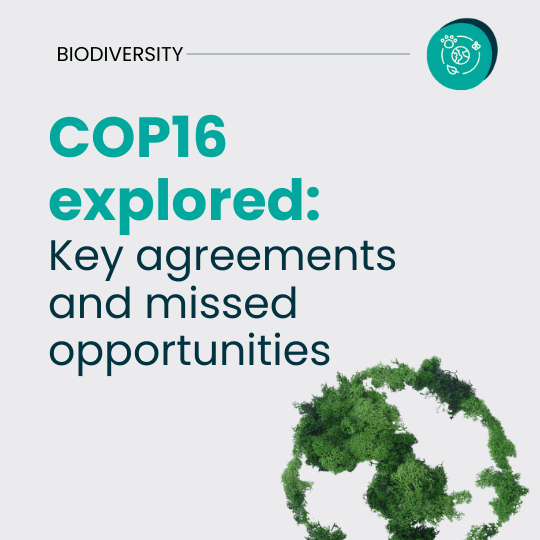
The conclusion of the 16th meeting of the Conference of Parties to the Convention on Biological Diversity (CBD COP16) marks a pivotal

As young people in Europe, we expect European countries at COP 16 of the Convention on Biological Diversity (CBD) to prioritise bold,
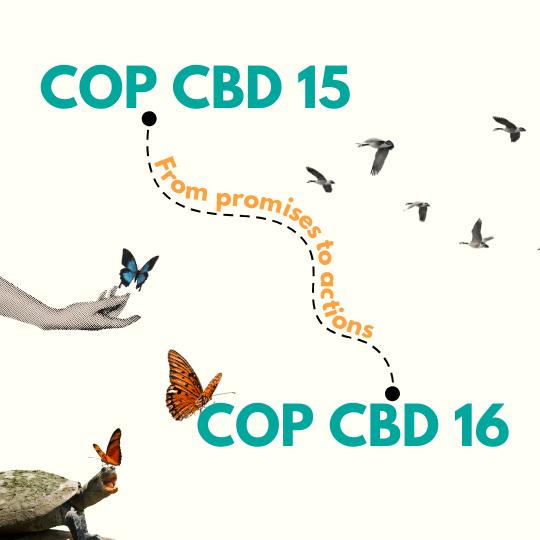
With the next conference of the parties to the convention on biological diversity (COP 16) right around the corner, let’s look back
European Youth statement ahead of COP 16
https://yeenet.eu/wp-content/uploads/2024/02/position.png 250 250 Eva Kloudová https://yeenet.eu/wp-content/uploads/2018/11/logo-yee-728x1030.png Eva Kloudová2024-10-17 15:19:182024-10-18 15:44:51European Youth statement ahead of COP 16
Investing in biodiversity protection is not just about preserving nature; it’s an investment in our future and economy. The EU has been funding nature conservation since the early 1980s, and in 1992, it launched its flagship funding program, LIFE.
Over the past 30 years, the LIFE program has co-financed numerous environmental and climate-related projects, improving the conservation status of 435 species and reducing greenhouse gas emissions. These projects have also contributed to public education, the expansion of the Natura 2000 network, and improved environmental governance.
The European Commission found that the LIFE program generated a tenfold return on the €3.46 billion invested from 2014 to 2020. In conclusion, investing in nature enhances social and economic prosperity for both current and future generations.
The coming months represent a key opportunity to address financing for biodiversity conservation and restoration measures across the European Union (EU). By 1 July 2025, the European Commission will release its proposal for the next Multiannual Financial Framework (MFF), officially kickstarting the period of negotiations between Member States and the European Parliament.
Effective and well-targeted financing is crucial for achieving EU biodiversity objectives, but significant funding gaps represent a serious impediment to successfully addressing biodiversity loss. The current financing needs from 2021 to 2030 were estimated at EUR 20 billion a year and changed to EUR 48.15 billion per year based on more recent calculations.
With the recent adoption of the Nature Restoration Law, it is crucial to support Member States in effectively implementing and enforcing its provisions. However, stricter financial regulations and efforts to reduce public debt raise the potential for intense debates regarding the allocation of resources within the EU, particularly concerning expenditures related to biodiversity.
Though focused on the post-2027 MFF, this paper also takes a broader perspective on biodiversity financing and considers the longer-term need to re-evaluate current approaches. The proposals are therefore designed to put biodiversity on a path to recovery beyond the next funding period to build a safer, healthier future for people and nature.
Help us spread the word! Share this statement
Learn more about our work on biodiversity

National Restoration Plans (NRPs) are a cornerstone of the Nature Restoration Law (NRL), outlining how Member States (MS) will implement the regulation

As European youth, we hold all relevant decision-makers accountable for this grave backsliding in European conservation law. We call for the return

The conclusion of the 16th meeting of the Conference of Parties to the Convention on Biological Diversity (CBD COP16) marks a pivotal
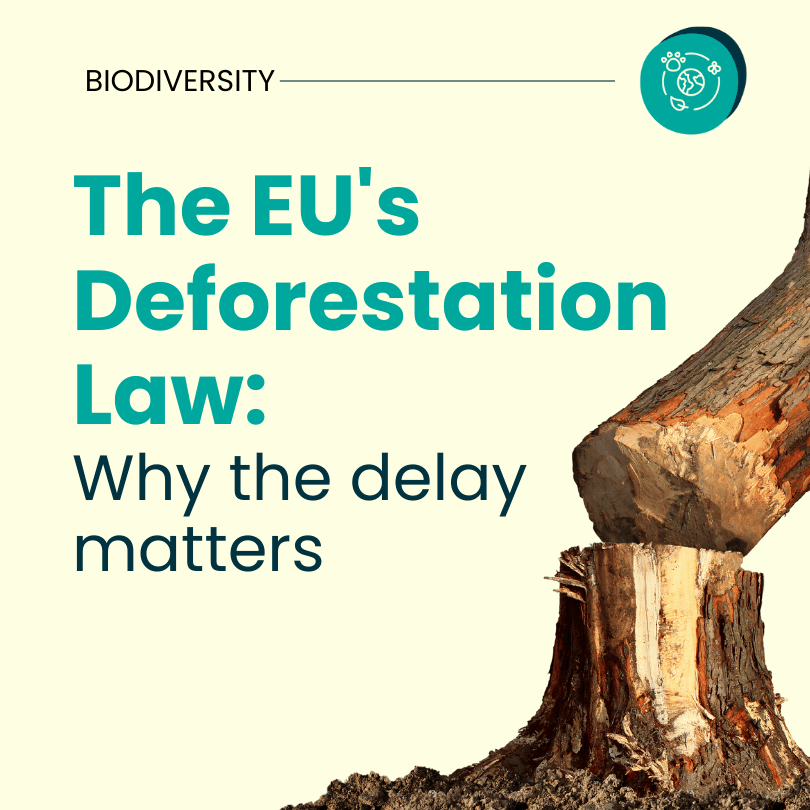
Despite the law’s importance in combating deforestation, the European Union recently announced a 12-month delay.
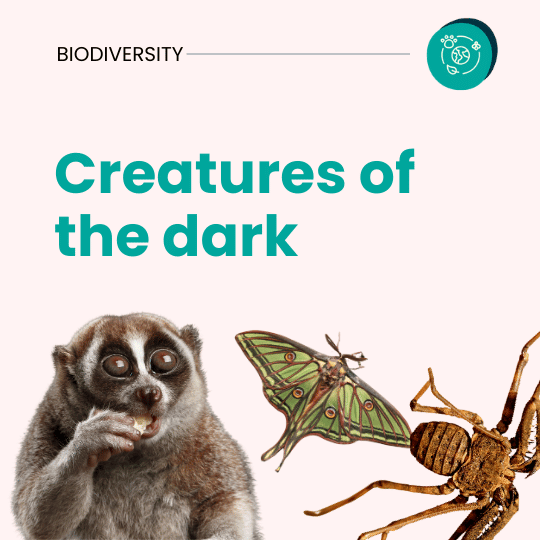
While nighttime activities are popular with humans for a few nights a year, some creatures keep it creepy all year round.

As young people in Europe, we expect European countries at COP 16 of the Convention on Biological Diversity (CBD) to prioritise bold,
How the next EU budget must deliver for biodiversity | Joint Statement
https://yeenet.eu/wp-content/uploads/2024/02/position.png 250 250 Eva Kloudová https://yeenet.eu/wp-content/uploads/2018/11/logo-yee-728x1030.png Eva Kloudová2024-08-21 11:26:202024-08-21 11:35:55How the next EU budget must deliver for biodiversity | Joint Statement
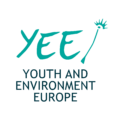
Ending Bottom Trawling: A Call for Real Protection of the Marine Environment
What is bottom trawling and why is it problematic
Bottom trawling is one of the most destructive fishing methods used worldwide, with as much as 40% of sea life being removed during a single trawling pass. The large weighted nets being dragged across the ocean floor are responsible for vast amounts of by-catch, discards and collapse of fish stocks.
Despite the restriction of human activities to conserve their rich biodiversity, Marine Protected Areas (MPAs) suffer greatly from the effects of bottom trawling. Even with its devastating and irreversible consequences, bottom trawling is still allowed in 90 percent of all offshore EU MPAs.
The impact of bottom trawling on marine ecosystems
Bottom trawling is responsible for reducing the complexity, productivity, and biodiversity of seafloor habitats, with sponges and corals facing the highest impacts. Unfortunately, most affected ecosystems are unable to recover from the damage they endure. For the few that do manage to recover, the estimated recovery time is estimated to be between 7.5 and 15 years.
The impact of bottom trawling on climate change
Bottom trawling not only causes significant harm to marine life, but according to a recent study, it also contributes up to 370 million metric tons of carbon dioxide to the atmosphere annually. The same study discovered that within an average of years, between 55 and 60 percent of emissions from underwater bottom trawling are released into the atmosphere, while the remaining CO2 can lead to more acidic conditions in the areas where it has been released, thus clearly contributing to the greenhouse effect and global warming of our planet.
The EU’s position on bottom trawling
Currently, there only exists an EU-wide ban on bottom trawling at depths greater than 800 metres, however the EU aims to extend a bottom trawling ban to all its MPAs by 2030, urging its Member States to draw up national roadmaps towards a bottom trawling plan as part of the 2023 Marine Action Plan (find our article about the EU’s Marine Action Plan here).
At the moment, Greece and Sweden are the only EU Member States to have announced a ban on bottom trawling in all their national marine parks and protected areas, with Sweden extending the ban to all its territorial waters (up to 12 nautical miles from the shore). This marks a significant step forward for these countries in the protection of marine biodiversity.
In contrast, the majority of EU countries have missed this year’s March deadline to outline national roadmaps for phasing out bottom trawling. The EU’s national governments need to demonstrate greater ambition for marine protection and commit to the Marine Action Plan and the EU Biodiversity Strategy 2030.
Protecting 30% of its marine areas by 2030 is incompatible with the highly damaging practice of bottom trawling, therefore the European Commission must take further action to ensure compliance with the existing legislation in countries that still permit bottom trawling inside the MPAs of their territorial waters.
YEE and GYBN calls for a ban of bottom trawling in Marine Protected Areas
As representatives of young people committed to environmental protection, Youth and Environment Europe and Global Youth Biodiversity Network Europe strongly advocate for the conservation of marine ecosystems and the promotion of sustainable fishing practices. Our position on the issue of bottom trawling comprises the following:
- YEE and GBYN Europe firmly oppose bottom trawling in Marine Protected Areas. This fishing method is highly destructive to seafloor ecosystems, causing irreversible damage to habitats such as coral reefs and seagrass beds. To achieve the 30×30 goal of protecting 30% of European waters by 2030, MPAs must offer genuine protection, which is incompatible with the destructive nature of bottom trawling. The practice of bottom trawling also needs to be reviewed in cases where it takes place close to MPA boundaries, in sensitive habitats such as spawning grounds, and in coastal waters.
- We show our strong support for ongoing initiatives by NGOs and civil society groups that advocate against bottom trawling. Notable examples include the joint campaign led by Oceana, Seas at Risk, Sciaena, and the Irish Wildlife Trust, as well as awareness raising and lobbying by WWF, Blue Ventures, the Blue Marine Foundation, Client Earth, and others. These organisations play a crucial role in raising awareness and driving policy changes.
Bottom trawling is a destructive practice that poses a significant threat to marine ecosystems and biodiversity.
As YEE and GYBN Europe, we urge EU Member States to prioritise ocean conservation and take decisive action. We firmly believe that young people, as the voice of the future, hold the power to enact the change they envision. With the recent EU elections, it is crucial for youth to push the newly elected MEPs to take action towards the protection of our oceans. Advocacy for stronger regulations, such as those in the Marine Action Plan, is essential to safeguard marine ecosystems. Join advocacy campaigns, engage with environmental organisations and use your voice to demand the preservation of our seas.
Help us spread the word! Share this statement
Learn more about marine conservation
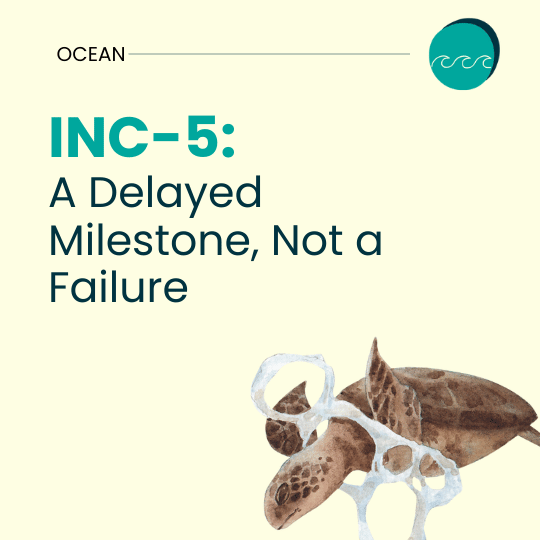
This session was supposed to be the “end of the beginning,” when the world would step out with the first-ever global plastic
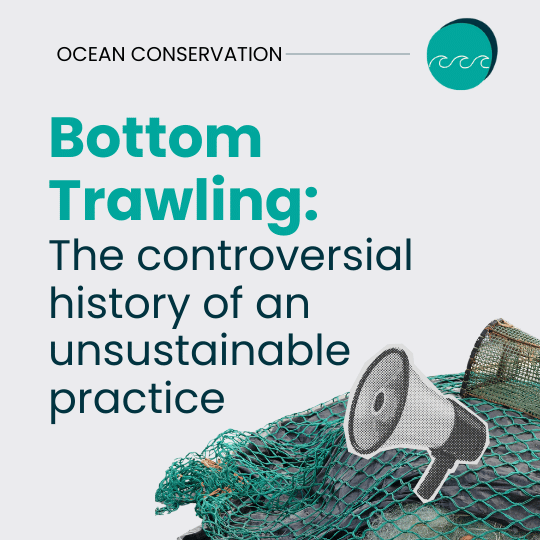
Bottom trawling involves dragging a weighted net or a rigid frame along the ocean floor. Despite its economic advantages, bottom trawling is

Youth and Environment Europe and Global Youth Biodiversity Network (GYBN) Europe Advocate for a Complete Ban on Bottom Trawling in Marine Protected

YEE Calls for Ambitious National Roadmaps for EU Marine Action Plan Implementation, including a ban on bottom trawling in MPAs

This session was supposed to be the “end of the beginning,” when the world would step out with the first-ever global plastic treaty, which did not happen. However, calling INC-5 a failure would overlook the complexities of negotiating and treaty-making and the leap forward that took place at INC-5.

Bottom trawling involves dragging a weighted net or a rigid frame along the ocean floor. Despite its economic advantages, bottom trawling is contentious due to its considerable environmental and ecological impacts.
Ending Bottom Trawling: A Call for Real Protection of the Marine Environment
https://yeenet.eu/wp-content/uploads/2024/02/position.png 250 250 YEE https://yeenet.eu/wp-content/uploads/2018/11/logo-yee-728x1030.png YEE2024-06-28 14:28:572024-06-28 16:42:42Ending Bottom Trawling: A Call for Real Protection of the Marine Environment
Recommendations to the EU Commission
YEE drafted these recommendations to the EU Commission on how to address the gaps in the exercise of Aarhus rights with regards to European youth. More specifically, the recommendations focus on the absence of youth participation in NECPs processes and its concerning implications, calling the Commission to call Member States to fill this gap as soon as possible and with adequate measures.
These recommendations are complemented by YEE’s country-specific reports on youth participation in the NECP processes in Bulgaria, Cyprus, Greece and Italy.
What is included in the position statement
The Commission should monitor the effective exercise of these rights among Member States, particularly amidst the observed shrinking of civic space, especially among young people and youth organisations. It is imperative to safeguard democratic participation rights among the youth population for more ambitious and effective climate action.
The poor exercise of Aarhus rights among European youth is evident in their non-participation in MCED and consultation processes concerning NECPs revision. Member States’ and EU’s failure to involve younger generations and their representative organisations undermines the rights of those who will bear the consequences of NECPs outcomes well into the future.
“There is a need to provide opportunities to engage in these processes that are specifically designed in such a way that takes into account the needs, opportunities and resources that young people have to engage in the deliberation.”
Learn about other campaigns that YEE supports

National Restoration Plans (NRPs) are a cornerstone of the Nature Restoration Law (NRL), outlining how Member States (MS) will implement the regulation

Today, we’re leaving X as an act of solidarity and a commitment to our values. This platform no longer aligns with our

As European youth, we hold all relevant decision-makers accountable for this grave backsliding in European conservation law. We call for the return

This document is an invitation to rethink and act, setting ambitious goals for the textile sector that align with biodiversity and climate

As European youth, we acknowledge our region’s historic responsibility for global emissions and call for urgent, just climate action. In solidarity with

As young people in Europe, we expect European countries at COP 16 of the Convention on Biological Diversity (CBD) to prioritise bold,

National Restoration Plans (NRPs) are a cornerstone of the Nature Restoration Law (NRL), outlining how Member States (MS) will implement the regulation to achieve its overall targets for 2050 and intermediary targets for 2030 and 2040. The European Commission has proposed a uniform format for NRPs, and this draft is open for public feedback until 7 February 2025.

Today, we’re leaving X as an act of solidarity and a commitment to our values. This platform no longer aligns with our mission for transparency, equity, and sustainability.
More To Explore
Youth Participation in National Energy and Climate Plans
https://yeenet.eu/wp-content/uploads/2024/02/position.png 250 250 Eva Kloudová https://yeenet.eu/wp-content/uploads/2018/11/logo-yee-728x1030.png Eva Kloudová2024-05-30 12:27:042024-05-30 12:50:31Youth Participation in National Energy and Climate Plans
EU Marine Action Plan
More than a year since the EU Marine Action Plan was adopted, there is a critical need to ensure that both the European Commission and Member States are held accountable for its effective implementation. The success or failure of this initiative will hinge upon the national roadmaps to be submitted by each Member State by the end of March. The publication of these national roadmaps will be closely monitored, especially considering the tendency of Member State governments to oppose ocean protection matters, often favouring economic interests over environmental ones. This also became evident in the disappointing response of the European Parliament (EP) to the Communication, which rejected the majority of its content.
Youth and Environment Europe strongly supports the gradual phasing out of bottom trawling in all marine protected areas (MPAs) by 2030 as proposed in the Marine Action Plan. This would be in line with an agreement made between 196 countries, including the EU, during the Conference of the Parties to the UN Convention on Biological Diversity (COP15) to reach a 30% target of protected land and oceans by 2030 in a landmark agreement for the protection of biodiversity. The method of bottom trawling is notorious for its detrimental impact on marine ecosystems due to several reasons, one of which is significant by-catch, such as marine mammals, seabirds, and other fish species. Bottom trawling can also cause extensive damage to sensitive habitats, disrupting the balance of marine ecosystems and damaging biodiversity. Not least because of the use of bottom trawling, European seas are in a severe environmental crisis. The European Environment Agency recently reported that “almost all marine species groups appear to be in bad condition throughout Europe’s seas, with mixed recovery trends”.
The Parliament had a chance to advocate strongly for ocean conservation shortly before the elections and urge the EU Member States to align its fisheries with nature protection policies. They missed this opportunity: Their report on the Marine Action Plan takes a concerning stance towards the use of harmful fishing equipment, suggesting to continue using bottom trawling within MPAs. The European People’s Party (EPP) holds the view that the proposed ban of bottom trawling in MPAs puts the future of fishermen at risk, labelling the Action Plan “discriminatory”. While coastal communities and the impact of the Marine Action Plan on fishers must not be ignored, YEE believes that this pure focus on the economic impact is too short-sighted. The livelihoods of coastal communities ultimately depend on seas with good environmental status and healthy fish stocks, which can simply not be reconciled with the practice of bottom trawling in MPAs. We need cross-cutting and forward-thinking policymaking to address economic concerns in the fisheries sector alongside the climate and nature crises, including support to fishers in transitioning away from destructive fishing gear to minimise negative socio-economic effects.
As Youth Environment Europe, we call upon all EU Member States to commit promptly and effectively to implementation of the Marine Action Plan, and urge the Commission to conduct and publicly release science-based assessments of their national roadmaps. Furthermore, we demand that any identified weaknesses be addressed by Member States, and call for close monitoring and enforcement to ensure their timely implementation. Only through concerted effort and accountability can meaningful progress be made towards safeguarding our marine environment for future generations.
Help us spread the word! Share this statement
More To Explore
EU Marine Action Plan
https://yeenet.eu/wp-content/uploads/2024/02/position.png 250 250 Eva Kloudová https://yeenet.eu/wp-content/uploads/2018/11/logo-yee-728x1030.png Eva Kloudová2024-03-06 14:45:302024-05-30 12:00:43EU Marine Action PlanOur mission
 YEE aims to unite environmental youth non-profit organisations in Europe in order to enhance international cooperation, increase knowledge about the climate crisis, raise awareness of environmental problems and to strengthen participation of youth in environmental decision-making.
YEE aims to unite environmental youth non-profit organisations in Europe in order to enhance international cooperation, increase knowledge about the climate crisis, raise awareness of environmental problems and to strengthen participation of youth in environmental decision-making.
Get in touch
Vinohradská 2165/48
120 00 Praha 2 – Vinohrady
Czech Republic
E-mail: yee@yeenet.eu


Financially supported by the European Youth Foundation of the Council of Europe. The views expressed do not necessarily reflect the official position of the Council of Europe



